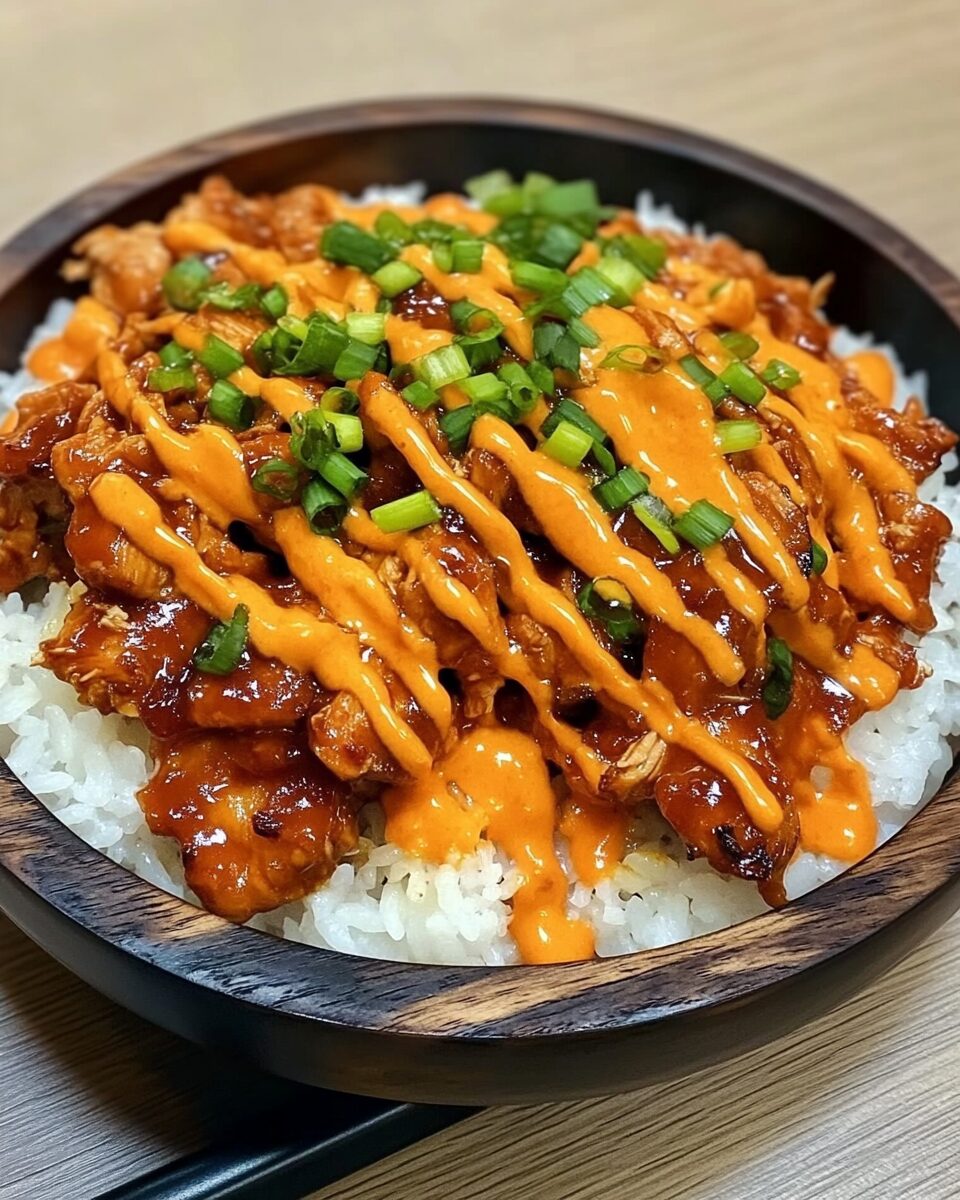These Korean Chicken Rice Bowls are a harmonious blend of savory, sweet, and spicy flavors, all nestled on a bed of fluffy jasmine rice. The tender chicken, coated in a rich marinade of soy sauce, sesame oil, and Gochujang, creates an explosion of taste in every bite. Fresh veggies like shredded carrots and red cabbage add a delightful crunch and vibrant colors, making this dish as visually appealing as it is delicious.
Perfect for a quick weeknight dinner or meal prep, these bowls are easy to assemble and endlessly customizable. Add a touch of Sriracha for extra heat or swap out vegetables to suit your taste. The simple combination of wholesome ingredients and bold flavors ensures this recipe will quickly become a household favorite.
Full Recipe:
Ingredients:
- 1 lb boneless, skinless chicken thighs, cut into bite-sized pieces
- 1/4 cup soy sauce
- 2 tablespoons sesame oil
- 2 tablespoons brown sugar
- 2 garlic cloves, minced
- 1 teaspoon grated ginger
- 1 tablespoon Gochujang (Korean chili paste)
- 1 tablespoon rice vinegar
- 2 cups cooked jasmine rice
- 1 cup shredded carrots
- 1 cup shredded red cabbage
- 1/4 cup chopped green onions
- 1 tablespoon sesame seeds
- Optional: Sriracha or additional Gochujang for spice
Directions:
- In a bowl, whisk together soy sauce, sesame oil, brown sugar, garlic, ginger, Gochujang, and rice vinegar.
- Add the chicken pieces to the marinade, tossing to coat evenly. Let it marinate for at least 15 minutes or up to 2 hours in the refrigerator.
- Heat a large skillet or wok over medium-high heat. Add the marinated chicken, including the marinade.
- Cook for 6-8 minutes, stirring occasionally, until the chicken is fully cooked and caramelized.
- Divide the cooked jasmine rice evenly into bowls.
- Top each bowl with the cooked chicken, shredded carrots, shredded red cabbage, and chopped green onions.
- Sprinkle sesame seeds on top and add optional Sriracha or extra Gochujang for a spicy kick.
- Serve immediately and enjoy!
Prep Time: 15 minutes | Cooking Time: 10 minutes | Total Time: 25 minutes
Kcal: 350 kcal | Servings: 4 servings
History and Inspiration
Korean Chicken Rice Bowls draw inspiration from classic Korean flavors, combining the savory, spicy, and slightly sweet notes that are iconic in Korean cuisine. The use of Gochujang, a fermented chili paste, is central to many Korean dishes and adds depth and complexity to the marinade. This recipe adapts these traditional flavors into a convenient and modern rice bowl format, making it accessible for home cooks who want to explore Korean-inspired meals without needing specialized cooking skills.
Ingredient Highlights
- Chicken Thighs: Preferred for their juicy texture and rich flavor. They hold up well to marinating and cooking, ensuring a tender result.
- Gochujang: A staple in Korean cooking, this fermented chili paste provides heat, umami, and a slight sweetness. It’s the key ingredient that makes this dish uniquely Korean.
- Sesame Oil: Adds a nutty aroma and richness to the marinade, balancing the spicy and savory elements.
- Fresh Vegetables: Carrots and red cabbage not only add crunch but also provide a nutritional boost and vibrant color to the dish.
Customization Tips
- Protein Variations: Substitute chicken thighs with chicken breasts, shrimp, or even tofu for a vegetarian option.
- Vegetable Choices: Feel free to add or swap vegetables like steamed broccoli, snap peas, or roasted sweet potatoes.
- Rice Alternatives: Replace jasmine rice with brown rice, quinoa, or cauliflower rice for a healthier twist.
- Heat Level: Adjust the amount of Gochujang or add Sriracha to tailor the spiciness to your preference.
Cooking Techniques
- Marinating for Maximum Flavor: Allowing the chicken to marinate for at least 15 minutes ensures the flavors deeply penetrate the meat. For the best results, marinate for up to 2 hours.
- Caramelizing the Chicken: Cooking the chicken along with the marinade helps thicken the sauce and creates a caramelized coating that enhances the overall flavor.
Nutritional Benefits
This recipe is a balanced meal, offering protein from the chicken, fiber from the vegetables, and energy-boosting carbohydrates from the rice. Gochujang and sesame seeds contribute additional nutrients, including healthy fats and essential minerals.
Pairing Suggestions
- Side Dishes: Serve with a simple cucumber salad or kimchi to add a refreshing and tangy element to the meal.
- Beverages: Pair with a light and crisp drink like green tea, iced barley tea, or even a sparkling water infused with lime.
Cultural Significance
Rice bowls like this are a popular meal choice in Korea due to their simplicity and versatility. They are a modern take on traditional dishes like Bibimbap, which also incorporates rice, vegetables, and a protein source, mixed with Gochujang.
Storage and Meal Prep
- Make-Ahead Option: You can prepare the chicken and vegetables ahead of time and store them separately. Reheat and assemble when ready to eat.
- Storage: Keep leftovers in an airtight container in the refrigerator for up to 3 days. Reheat gently in a skillet or microwave to maintain flavor and texture.
Flavor Profile
This recipe balances sweet, savory, and spicy flavors, which are hallmarks of Korean cuisine. The Gochujang chili paste is the star ingredient, offering a deep umami flavor combined with a mild heat that lingers pleasantly. The sweetness from brown sugar and the nuttiness of sesame oil round out the dish, creating a harmonious taste experience.
Nutritional Information
Each serving of this dish provides:
- Calories: 350 kcal (approx.)
- Protein: A good source of lean protein from chicken thighs, which helps support muscle health.
- Vegetables: Red cabbage and carrots are rich in vitamins A and C, antioxidants, and dietary fiber.
- Carbohydrates: The jasmine rice serves as a satisfying base and energy source. Swap with brown rice or quinoa for added fiber and nutrients.
Cultural Connection
The bowl format is inspired by Bibimbap, a traditional Korean dish that features rice topped with a variety of ingredients. While Bibimbap often uses a fried egg and various vegetables, this recipe simplifies the process while retaining the core elements of flavor and texture.
The use of Gochujang reflects the growing popularity of Korean ingredients worldwide. Historically, this chili paste has been a staple in Korean households for over 1,000 years, originally used as a preservative for meats and later evolving into a key flavoring agent.
Preparation and Cooking Tips
- Marinating for Depth: Marinating the chicken allows the sauce to penetrate the meat, ensuring a deeper, more robust flavor. For extra tenderness, add a splash of pineapple juice or grated pear to the marinade (a common Korean technique).
- Cooking the Chicken: Searing the chicken in a hot skillet ensures caramelization, locking in the marinade’s rich flavor. Be sure not to overcrowd the pan for even cooking.
- Rice Perfection: For fluffy rice, rinse it under cold water until the water runs clear. This removes excess starch and prevents clumping.
Serving Suggestions
These Korean Chicken Rice Bowls are versatile and customizable. Here are some serving ideas:
- Add-ons: Include a fried or poached egg for extra protein, or drizzle with Kewpie mayonnaise for a creamy touch.
- Toppings: Sprinkle roasted seaweed flakes (nori), kimchi, or crushed peanuts for added texture and flavor.
Storage Tips
- Refrigeration: Store leftovers in an airtight container for up to 3 days. Keep the rice, chicken, and vegetables separate to maintain their texture.
- Freezing: The cooked chicken freezes well. Thaw and reheat before serving over freshly cooked rice.
Why It’s Perfect for Busy Days
This recipe is designed for simplicity without sacrificing flavor:
- Quick Prep: The marinade comes together in minutes with pantry staples.
- One-Pan Cooking: Minimal cleanup makes it ideal for weeknight dinners.
- Meal Prep-Friendly: Prepare multiple servings at once and portion them into containers for an easy grab-and-go lunch.
Substitutions and Variations
- Vegetarian Option: Swap chicken with firm tofu or tempeh. Marinate and cook using the same method.
- Gluten-Free: Use tamari or coconut aminos instead of soy sauce.
- Low-Carb: Serve over cauliflower rice or mixed greens instead of jasmine rice.
- Extra Heat: Add sliced chili peppers or a drizzle of chili oil for spice lovers.
Background on Gochujang
Gochujang is a fermented chili paste that combines red chili powder, glutinous rice, fermented soybeans, and salt. Its fermentation process gives it a complex, savory-sweet flavor that enhances a wide range of dishes, from soups to marinades. In Korean households, it’s often paired with Doenjang (soybean paste) and Ssamjang (spicy dipping sauce) to complete the trio of essential condiments.
Visual Appeal
The vibrant colors of this dish—golden-brown chicken, orange carrots, purple cabbage, and green onions—make it a feast for the eyes. Plating it in a deep bowl showcases the layers of ingredients and makes it easy to mix everything together before eating.






